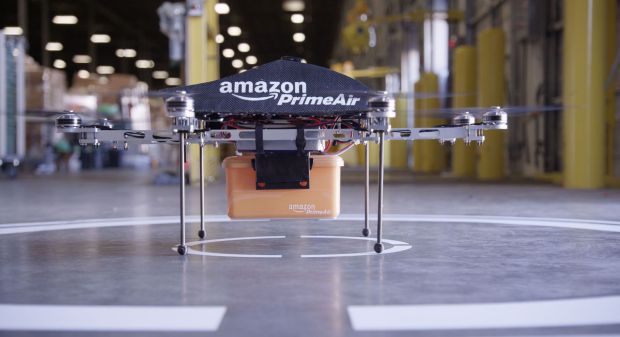Amazon Drones May Do More Than Just Fly

The drones being used by eCommerce giant Amazon may get a bit more creative when it comes to getting to a delivery location.
According to the company’s filing with the U.S. Patent and Trademark Office, it would like the option to hitch its unmanned aircrafts on both trucks or buses in order to complete a delivery journey is not out of the question.
In order to get close to delivery destinations or return from completed deliveries in a timely manner, the company is requesting its drones be able to land on a vehicle. Amazon said this would also conserve energy and allow for emergency landings, if needed.
GeekWire reported that Amazon’s approach to this would involve building relationships and agreements with transportation agencies and shipping companies. Compensation would be provided in exchange for the permission to hitch drones to their vehicles. Both vehicle marketing and GPS coordinates may be used in order for drones to best identify the vehicles that they are cleared to land on, the patent filing stated.
Under the system, a database will be created by Amazon of the vehicles it has established landing agreements with. The company would also look to send messages directly to the driver or transportation system when it wants to land a drone on a vehicle.
But it may still be some time before drone delivery becomes a retail reality.
Earlier this year, the Federal Aviation Administration (FAA) released updated regulations on the use of commercial drones in U.S. airspace, including rules that drones must fly no higher than 400 feet and can’t exceed weights of 50 pounds.
The news wasn’t seen as promising for the likes of Amazon’s high-flying delivery robots, especially the guideline that drones must always fly within line of sight of a human operator.
The rule stems from FAA logic on what it calls “unprotected persons,” which drones are prohibited from flying over. In fact, the agency’s press release makes little note of drones’ commercial potential at all, focusing instead on the fact that its primary purpose is to ensure the safety of this next generation of airborne transportation before seeing to its commercial potential.
“We are part of a new era in aviation, and the potential for unmanned aircraft will make it safer and easier to do certain jobs, gather information and deploy disaster relief,” U.S. Transportation Secretary Anthony Foxx said in a statement. “We look forward to working with the aviation community to support innovation, while maintaining our standards as the safest and most complex airspace in the world.”
